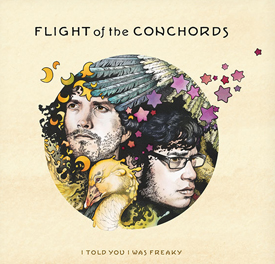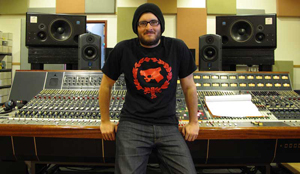On The Road With Flight of the Conchords
New York, NY — Fans of the HBO series Flight of the Conchords might have a hard time imagining slacker-heroes Bret McKenzie and Jemaine Clement racing between the show’s stage in Greenpoint, Brooklyn and recording studios city-wide to get all of the show music fully written and produced and albums of it recorded and mixed. But, that’s exactly what they did during both seasons of the award-winning series.

If I Told You I Was Freaky (Sub Pop, 2009)
Their second full-length record, I Told You I Was Freaky, comes out on Sub Pop in October, produced by Mickey Petralia and recorded by NYC-based engineer Matt Shane: the production team responsible for capturing all of FoTC’s musical antics for TV.
It’s a compilation of songs from season two — including the R. Kelly-inspired “We’re Both In Love With A Sexy Lady” and club anthem “Too Many Dicks (On the Dance Floor)” written/produced during the show’s production.
Shane describes, “As opposed to season one, most of the songs for season two hadn’t been performed live, so instead of starting out with two guitars, we were starting out with these full-up beats they worked up in the studio with Mickey, and then they’d add elements later to make it fit or change genres.
“The guys would do 12-hour days shooting during the week and then we’d be in the studio at nights and on the weekends. We split the work between a handful of studios — Mission Sound and Metrosonic in Williamsburg, One East, Looking Glass and Chung King in Manhattan, and A Bloody Good Record in Long Island City.”
In appropriate contrast to their TV persona, Flight of the Conchords is a highly active band, releasing singles via iTunes during the seasons, albums post-season (including a Grammy-winner) and touring in support of all. For their U.S. tour last Spring, the Conchords tapped Shane and My Morning Jacket FOH engineer Ryan Pickett to help them take the show on the road
BIGGER SHOWS, BIGGER PRODUCTION
“We were going to be doing way bigger houses than we did on their first, smaller tour last year, so they stepped up the production as well,” explains Shane. “They share management with My Morning Jacket, who happened to not be on the road at that time, so Ryan and Marc (Janowitz), MMJ’s lighting designer, were available to get involved.”
Being so familiar with the material, having recorded all the music, Shane took on monitor duties on the road. Orientation took place at Soundcheck in Nashville, where the crew staged the show and Shane and Pickett put their heads together on how to best present this unique act, live.
FoTC enlisted fellow kiwi and multi-instrumentalist Nigel Collins to fill in musically on cello, background vocals, keyboards and percussion. “The second season had just finished airing and the songs had been created in the studio and never played live,” says Shane. “With only a few days of rehearsal, the guys used the first couple weeks of the show, during sound-checks and even the actual concerts, to sort of reverse-engineer some of these fully produced tracks and bring it back down to two guitars and vocals.”
Technology helped them genre-hop and do their best Prince falsetto or T-Pain croon. “They use a lot of effects in some of their songs — like in hip-hop tunes where they copy the AutoTune effect, and they wanted to be able to do that, live,” says Shane. “So, we researched and found the new ElectroHarmonix Voicebox, a vocal synth processor pedal that matches whatever reference signal you send to it. With that, they were able to do all kinds of things — harmonies, vocoder, etc.”
RULE ONE OF COMEDY CONCERT: EVERYTHING IS MATERIAL
Though rehearsal got everyone in gear, the FOTC shows were largely dictated by band-audience interplay and therefore quite unpredictable. “It was very common that songs would not be done the same way twice,” explains Shane. “Jemaine would play an Omnichord on a song in sound-check and then during the show, he’d stay on guitar for that song.”
Pickett adds, “I’ve never had to be on my toes quite so much; for having such few musicians on stage, it was pretty intense. I never knew where they might go, because of dark-outs and things like that, which kept it fun.”
The variable set-list became a joke with the crew. “It was just a list of 30 songs, but they hardly ever went in order and rarely played them in the same order twice,” describes Shane. “That improvisation added to the comedy routine. So, if Marc didn’t bring the lights up or didn’t change the colors in time for a sad song, they’d ask, ‘Can you make it look like we’re inside a tear?’ They’d make us part of the show. I’d become part of the bit if I had to run out and fix something. Everything is material.”
RULE TWO: THEREFORE, EVERYTHING HAS TO BE HEARD
Allowing for audience interaction in large halls, Pickett had the band on wedges. “In-ears just wouldn’t have worked for this show, since every song came out so different each night, in terms of tempo and instrumentation,” he explains. “And sometimes one of the guys would lay out and then come back in — if they were on in-ears and the levels were locked in, and there were no ambient levels or they couldn’t hear the other guy’s wedge or bleed, etc. they’d be alone, out in space.”
Diction and comic timing were key show elements that needed to come across as much as the music in these large halls. “I’ve done a few acoustic arrangements, but the whole comedy factor of this show really adds a whole new element to what we’re doing,” adds Pickett. “Every little corner of the room needs to hear what’s being said, and their accent is a bit of an obstacle for the audience to begin with, so you really had to be on your mark.”
Shane elaborates, “It took a lot of tricky microphone placement and EQ to give us the most headroom before feedback possible. We never knew where they were going to go during any given song, so we had a lot of mics open all the time and since they were on wedges, there was a lot of foldback that Ryan had to deal with.”
Never a dull moment during this tour, Shane also ran sessions with the guys on days off to finish the next album. “We’d be doing vocal overdubs in dressing rooms so that we could send stuff off to Mickey who was re-mixing the songs for the record.”
Look out for the Flight of the Conchords’ record, I Told You I Was Freaky, in October.
Matt Shane lives and works in NYC and is currently working on a new record by Robbers On High Street and on mixes for Hamacide and The Woods. Get in touch with him via http://www.mshane.com.
A live sound and recording engineer based in North Carolina, Ryan Pickett is often on the road, mixing FOH for My Morning Jacket and, most recently, The Decemberists.
Please note: When you buy products through links on this page, we may earn an affiliate commission.







